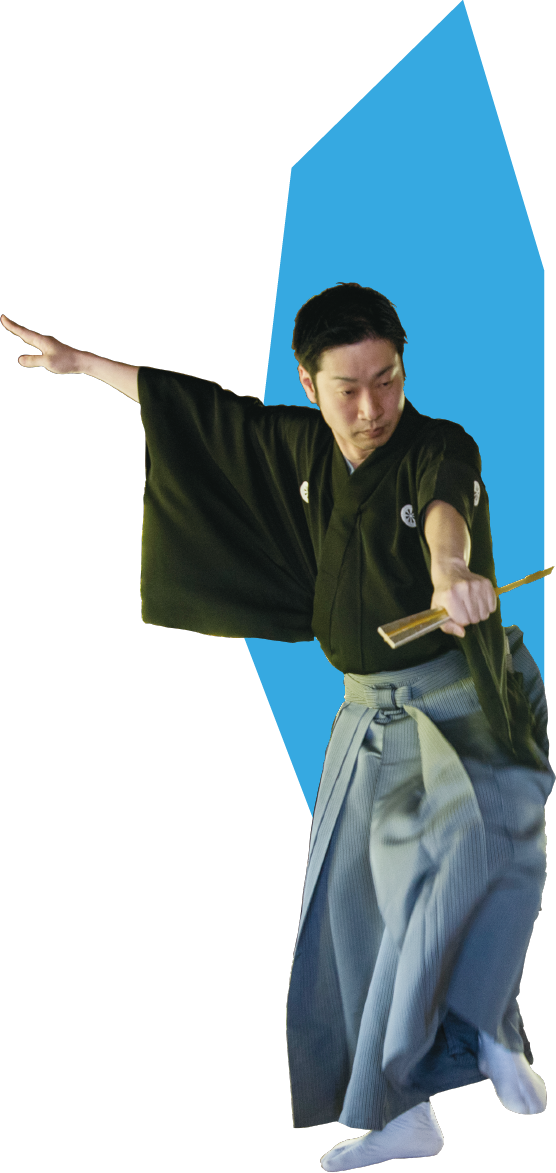MINI 2019, June-July Issue

Kata gives freedom.
And yet is eventually lost.
What lies beyond it is a style of one’s very own.
An interview with Udaka Tatsushige, the young Noh shite-kata (or protagonist role actor) of the Kongo school who has been in charge of Murin-an’s Noh lectures over the past two years.
The dynamic world of Noh contains many hints for how to live a fulfilling daily life.
Q. Isn’t tremendously difficult to gain a kata (movement pattern form) in Noh performance?
Yes, it was very hard for me as a teenager. Because my mind and body were continually changing.
Plus, I found it hard to learn the order of Noh dances, and when I was young, I had my failures exposed in front of others and was severely scolded! This was both tough and hurtful. But I was able then to change my thinking. Being scolded doesn’t hurt if you aren’t at fault. If you truly thought you weren’t at fault, you’d be able to respond with a retort. I was able to accept the fact that the reason I couldn’t make any retort was that I hadn’t mastered my kata. I then began to wonder, “Why can’t I do it?” From then on, I devoted myself to my training.
Q. What were your training methods?
They differed according to each of my teachers. Noh has kata, but it doesn’t have a method. In my case, my method was to take a look at the overall flow of what my teacher did and then to emulate that. When I accepted that I couldn’t do it, I stopped trying to emulate what I had just seen and would have my teacher show me the flow one time before suggesting that he “give me a little time” so that I had time to repeat the image of his movements in my mind. That inevitably results in some blank spots, but by repeating the movements I tried to fill these in.
Q. What lies beyond the repetition of kata?
Kata is a means of encountering your true self. People think that after one attains kata individuality tends to disappear, but the truth is that without kata you cannot be free. It allows you to see other things clearly. To relate it to fashion, it’s not prêt-à-porter, but rather haute couture. If it doesn’t fit your body perfectly, you can’t call it kata. Repeatedly emulate your teacher’s movements faithfully and incorporate their flow in your own body. Then, at some point, you will notice something definitively different between you and your teacher. You will then “observe.” Next comes the repetition of trial and error.
Q. The method of learning kata is something that you devise yourself, isn’t it?
Yes. These days, many people think that doing things without a method winds up in a dead-end, but I’d like people to think of it as being, to the contrary, an opportunity. To be left to one’s own devices in the middle of the learning process often leads to tremendous secondary results. Essentially, it means learning based on “observation,” and through this process, in my own way, I attained a method of turning other people’s experiences into my own experiences. This is a very powerful resource when it comes to spending one’s life in the work of “depicting” other people on the stage. And isn’t it a necessary process for other kinds of work as well?
Q. What freedom has your kata given you?
Something like a stance that says that what has once been gained continues changing constantly and will later be lost and that we continue gaining kata every day by facing ourselves. In any case, at some point, having kata within yourself allows you to think about how to output it. The time that you’re on the stage actually using kata is when you’re at your freest.
Now that’s style.
Our next Noh seminar will be held on June 5 (Wed.) at 7:00 PM. Discounts for all aged
35 or younger.
See our website for details. This column is still ongoing. Look forward to the second half in our next issue!
